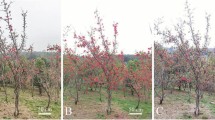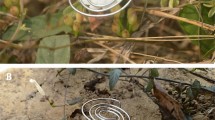Summary
Flower structure, especially the anther–stigma separation (ASS), is well known to affect pollination efficiency, and thus to potentially increase or decrease seed production in crops. Therefore, investigating the relationship between flower characteristics and pollination ability is crucial to a full understanding of mechanisms to improve F1 seed production in Brassica rapa. We used image analysis to measure three flower characteristics: short stamen height (SSH); long stamen height (LSH); and pistil height (PH) in seven cultivars. We calculated the ratio of PH to LSH as an index of anther–stigma separation (ASS). We investigated the number of pollen grains (NPG) deposited on the stigma and the seed-set percentage (SSP) under open-pollination and self-pollination conditions (with and without insects, respectively). Nested ANOVA indicated significant differences between the seven cultivars in the floral characteristics except for PH. Moreover, much larger variation was observed in NPG and SSP than in floral characteristics. Although stepwise multiple regression analysis indicated that plants with relatively high PHs produced more seed under self-pollination, the number of seeds that resulted from self-pollination did not affect seed production because of incompatibility. Therefore, the effect of the spatial position of pistils on the F1 seed production was low. Possibly other factors such as the total pollen production and visiting times of pollinators were important factors in the low yields observed in some cultivars
Similar content being viewed by others
References
Campbell, D.R., 1989. Measurement of selection in a hermaphroditic plant: variation in male and female pollination success. Evolution 43: 318–334.
Conner, J.K., R. Davis&S. Rush, 1995. The effect of wild radish floral morphology on pollination efficiency by four taxa of pollinators. Oecologia 104: 234–245.
Conner, J.K., S. Rush&R. Jennetten, 1996. Measurements of natural selection on floral traits in wild radish (Raphanus raphanistrum). I. Selection through lifetime female fitness. Evolution 50: 1127–1136.
Elle, E.&J.D. Hare, 2002. Environmentally induced variation in floral traits affects the mating system in Datura wrightii. Funct Ecol 16: 79–88.
Holtsford, T.P., 1992. Genetic and environmental variation in floral traits affecting outcrossing rate in Clarkia tembloriensis (Onagraceae). Evolution 46: 216–225.
Horisaki, A.&S. Niikura, 2004. Effectiveness of insect-pollination to evaluate the level of self-incompatibility and genetic variation in Brassica rapa L. Breed Sci 54: 291–295.
Horisaki, A., N. Tanaka&S. Niikura, 2003. The effectiveness of insect-pollination test to evaluate the level of self-incompatibility and their genetic analysis in radish (Raphanus sativus L.). Theor. Appl. Genet. 107: 1009–1013.
Karron, J.D., R.T. Jackson, N.N. Thumser&S.L. Schlicht, 1997. Outcrossing rates of individual Mimulus ringens genets are correlated with anther–stigma separation. Heredity 79: 365–370.
Kobayashi, K., A. Horisaki, S. Niikura&R. Ohsawa, 2004. Diallel analysis of floral characters in Raphanus sativus L. Breed Res 6 (Suppl 2): 169 (in Japanese).
Kudo, G., 2003. Anther arrangement influences pollen deposition and removal in hermaphrodite flowers. Funct Ecol 17: 349–355.
Levin, I., A. Cahaner, H.D. Rabinowitch&Y. Elkind, 1994. Effects of the ms10 gene, polygenes and their interaction on pistil and anther-cone lengths in tomato flowers. Heredity 73: 72–77.
Matsubara, S., 1980. Overcoming self-incompatibility in Raphanus sativus L. with high temperature. J Am Soc Hort Sci 105: 842–846.
Motten, A.F.&J.L. Stone, 2000. Heritability of stigma position and the effect of stigma–anther separation on outcrossing in a predominantly self-fertilizing weed, Datura stramonium (Solanaceae). Am J Bot 87: 339–347.
Murcia, C., 1990. Effect of floral morphology and temperature on pollen receipt and removal in Ipomoea trichocarpa. Ecology 71: 1098–1109.
Namai, H., R. Ohsawa&N. Ushita, 1992. Independent evolution of automatic self-pollination ability and self-fertility in Raphanus sativus L. and Brassica juncea (L.) Czern. et Coss.: the pathway from allogamous plant to autogamous plant. In: Proc XI Int Symp Embryology and Seed Reproduction, pp. 387–388.
Nishihiro, J., I. Washitani, J.D. Thomson&B.A. Thomson, 2000. Patterns and consequences of stigma height variation in a natural population of a distylous plant, Primula sieboldii. Func Ecol 14: 502–512.
Okazaki, K.&K. Hinata, 1987. Repressing the expression of self-incompatibility in crucifers by short-term high temperature. Theor Appl Genet 73: 496–500.
Ruffio-Chable, V., Y. Herve, C. Dumas&T. Gaude, 1997. Distribution of S-haplotypes and its relationship with self-incompatibility in Brassica oleracea. Part 1. In inbred lines of cauliflower (B. oleracea var. botrytis). Theor Appl Genet 94: 338–346.
SAS institute Inc., 2002. JMP statistics and graphics guide, version 5. SAS Institute Inc., Cary, NC, USA.
Uga, Y., Y. Fukuta, R. Ohsawa&T. Fujimura, 2003a. Variations of floral traits in Asian cultivated rice (Oryza sativa L.) and its wild relatives (O. rufipogon Griff.). Breed Sci 53: 345–352.
Uga, Y., Y. Fukuta, H.W. Cai, H. Iwata, R. Ohsawa, H. Morishima&T. Fujimura, 2003b. Mapping QTLs influencing rice floral morphology using recombinant inbred lines derived from a cross between Oryza sativa L. and Oryza rufipogon Griff. Theor Appl Genet 107: 218–226.
Yang, C.-F., Y.-H. Guo, R.W. Gituru&S.G. Sun, 2002. Variation in stigma morphology—How does it contribute to pollination adaptation in Pedicularis (Orobanchaceae)? Plant Syst Evol 236: 89–98.
Yashiro, K., R. Ohsawa, N. Ushita&H. Namai, 2001. Variations in reproductive systems within brown mustard (Brassica juncea) cultivars. Breed Res 3: 21–30.
Yoshioka, Y., A. Horisaki, K. Kobayashi, Syafaruddin, S. Niikura, S. Ninomiya & R. Ohsawa, 2005. Intraspecific variation in the ultraviolet colour proportion of flowers in Brassica rapa L. Plant Breed 124: 551–556.
Young, H.J.&M.L. Stanton, 1990. Influences of floral variation on pollen removal and seed production in wild radish. Ecology 71: 536–547.
Author information
Authors and Affiliations
Corresponding author
Rights and permissions
About this article
Cite this article
Syafaruddin, Horisaki, A., Niikura, S. et al. Effect of floral morphology on pollination in Brassica rapa L. Euphytica 149, 267–272 (2006). https://doi.org/10.1007/s10681-005-9074-3
Received:
Accepted:
Published:
Issue Date:
DOI: https://doi.org/10.1007/s10681-005-9074-3




